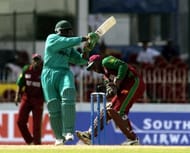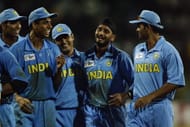How do we remember a great tournament? Packed houses, exciting finishes, or at the most basic level, your team winning the tournament. A multi-nation tournament, be it in any sport, comes with larger expectations from the sport’s lovers. It is but natural that the bar of expectations for such a tournament, organised by the sport’s governing body, is even higher.
However, something seems amiss with the ICC Champions Trophy, which has always fought hard to find meaning to its existence. The name of the tournament was never constant, neither was its changing format, and time and again the tournament’s viability was questioned by the administrators themselves. All this resulted in a step-motherly treatment to the tournament from administrators and fans alike. So much so, that it is being scheduled now just to fulfil the commitments made to the broadcasters and the sponsors.
The 2002 edition of the tournament can be said to have marked the epoch in terms of the absolute senselessness of the Champions Trophy. For starters, the tournament’s timing couldn’t have been worse. 12 out of the 14 teams to play at the World Cup in South Africa were playing in a ‘mini World Cup’ in Sri Lanka just six months prior to the mega event. Secondly, the scheduling increased the duration of the tournament from a week-10 days in 1998 and 2000 to 20 days, which was almost as long as the World Cup. As such, there was nothing ‘mini’ about the ‘mini World Cup’.
Pool matches meant that ICC Knockout Trophy became the Champions Trophy. The number of participants was increased to 12, accommodating 10 Test playing nations (yes, now Bangladesh was a Test playing nation) and 2 associates. This meant that Netherlands got an opportunity to play against full member nations effectively for the first time in six years (the last time they played full member nations was during the 1996 World Cup). Last but not the least, fans in India saw the coverage shift from ESPN Star to SET Max and ‘Extra Innings’ became a part of our lives. This also meant that before Rochelle Rao and even Mandira Bedi graced our TV Sets, Ruby Bhatia was introduced (read ‘shoved down viewer’s throats’) to the fans in the pre-match show as the channel attempted to bring about women viewership for the matches (*facepalm*).
But still there were bright spots for some fans to look forward to the tournament. India were coming back from England after drawing the Test series 1-1 and winning the Natwest Trophy after an epic final. Sri Lanka was hosting its first multi-nation tournament without the threat of terrorist attacks and civil war looming. Thus, all the teams confirmed their participation. Lastly, as every Indian fan would remember fondly, giants such as Australia and South Africa were facing their most dreaded nemesis in slow and turning wickets.
The pool system allowed each pool to have two strong teams coupled with either an associate or a weak full member nation. To provide semblance of a Knockout, only one team progressed from each pool to the semifinals. Thus, Pool 3 was the strongest in terms of competition with India, Zimbabwe and England facing off. However, Pool 2 also saw some excitement as well with South Africa and West Indies providing some hara-kiri on the way.
Moments of the tournament
At the outset, I would say that Pools 1 and 4 provided for the most boring and one-sided games that One Day Cricket could come up with. It wasn’t as if the competition couldn’t have been fierce but Pakistan made heavy weather of reaching 200 against Sri Lanka which proved to be a canter for the Lankan Lions. Pool 4 on the other hand saw Glenn McGrath, with some exceptional new ball bowling by a fast bowler in sub-continental conditions, reduce New Zealand to 71 for 7 within the first 15 overs when batsmen tried to hit out (for those who might have forgotten, this tournament was played in the pre-powerplay era and the first 15 overs were a time when the field was pulled in).
Apart from that, the sheer one-sidedness of the Bangladesh and Dutch games need not be elaborated. Roland Lefebvre, the Dutch captain and one of the two players in the Netherlands squad to have played in the ’96 World Cup, put it before the match against the Lankans that they were there to learn. Learn they did, the hard way as they were brushed aside in 18 overs by Pakistan and by 206 runs by Sri Lanka.
Pool 2
Pool 2 saw South Africa pitted against Kenya and West Indies. The pool gave games which betrayed the David vs Goliath stature of the competition. South Africa would have been sent packing had Mervyn Dillon held his nerve with 3 needed off the last ball and not sent down a wide. While chasing a competitive 238, which was a match winning total at the Sinhalese Sports Club, South Africa were given a serious run for their money by the West Indies as they won by 2 wickets off the last ball. In the second game of the pool, Kenya faced West Indies against whom they had a perfect record and almost pulled off a repeat of Cuttack ’96, but fell short by 29 runs. The last game thankfully lived up to the expectations with South Africa bringing the Kenyans back to earth with a grounding 176-run defeat.
It could be said that the pool showed a good balance between bat and ball, though in terms of quality there could be serious doubts. While the numbers were seen on the board, yet it was more in the mould that batsman wanted to get out rather than being bowled out. The bright spot of the league games for me was actually Steve Tikolo, who took 3 wickets along with two fifties in two games, albeit the efforts came in losing causes.
Pool 3
Pool 3 saw India, England and Zimbabwe face off. Zimbabwe was handed a thrashing by England in a very one-sided game. However, the other two games featuring India saw emotions rise and fall quickly. In their first game against Zimbabwe, less known Douglas Hondo ran through our famed batting order to leave India at 87 for 5. It was then left to Rahul Dravid and Mohammad Kaif to steady the ship. Kaif, playing his first ODI innings since the epic 87 at Lord’s, smashed 111. Though, due credit must be given to Dravid as these were one of the 74 games when he kept wickets to accommodate Kaif at number 7. In difficult conditions, Dravid kept wickets for 50 overs and scored 71. If the match was played today, Dravid would definitely have had more MVP points than Kaif. The game wasn’t over as even a target of 289 didn’t seem difficult with India’s arch-nemesis of the 90s, Andy Flower to come. He played an exhilarating knock of 145 and that too after keeping 50 overs. The ‘keeper versus ‘keeper battle though was won by Dravid as he had more support from his teammates and India won by 14 runs.
The second game against England was a must win for both teams and England were vying for revenge for the Natwest Final. The Indian bowlers, after a fantastic start, got hit for plenty of runs by a certain Ian Blackwell who was playing his second ODI. It was his only moment of glory at the international level as he soon faded away. With 270 to chase, Sehwag and Ganguly came out as slayers sent by the devil himself and the haplessness faced by Hoggard, Caddick, Cork, Giles and Irani was palpable. Both scored exceptional hundreds and the word canter would sell India’s chase short as the run-chase was completed at close to 7 runs an over.
Semifinals
The semifinals pitted tournament favourites South Africa against India. India, riding on contributions from Sehwag, Dravid and Yuvraj, made a competitive 261. Herschelle Gibbs had other ideas and single-handedly tore the bowling to shreds. By the time Gibbs retired in the 37th over for 116, the Africans needed just 69 to win. The rest of the chase looked comfortable but Harbhajan Singh and Sehwag put India’s foot in the door. On a slow and turning track, the duo took five wickets for 62 between them and India pulled off a miracle win. The optimists uttered the ‘C’ word while the sceptics were quick to dismiss it as ‘fixed’. However, whatever be the case, one cannot deny that Yuvraj’s splendid catches to dismiss Graeme Smith and Jonty Rhodes were one of the best in a generation. It was befitting that one of the dismissals was that of the legendary Jonty Rhodes himself.
The track that exposed the demons of the South Africans against spin, spooked the Australians into submission against the Lankans two days later. Scoring at 8 an over with Gilchrist and Hayden pulverising Vaas and Gunaratne, Jayasuriya handed the ball to the veteran Aravinda De Silva. He was no Muralitharan but still had around a 100 ODI wickets to his name. In 10 overs, he conceded just 16 and picked up the wicket of Hayden. It pulled the handbrake of the Australian supercar and Jayasuriya used as many as 5 spinners to dismiss Australia for 162. Defending a paltry total against the hosts was never going to be easy and the hosts booked a place in the finals alongside India.
Final(s)
A tournament that was panned left, right and centre for off the field issues, had actually provided a week of entertaining games and the crowds pulled in for the final not only for one but two days. Both days were extremely identical with the slow track aiding the spinners and making a mockery of the seamers. Scores were similar and on both days, Sehwag showed glimpses of the kind of destruction he could inflict. However, it was not to be as the rain gods opened the flood gates on the Premadasa on both days, allowing India and Sri Lanka to share the spoils.
The 2002 Champions Trophy can be akin to the underdog with whom no one concerned had any expectations, were given hope and then left wanting for more. The edition pretty much sums up how the tournament’s existence has fared over the years.
As the 2013 edition starts, the ICC would sit and wonder whether the intention with which this tournament was started was achieved or not. Neither was it organised in any non Test playing nation post 2000 nor did it continue with the associates post 2004. Thus, it didn’t spread the game and the expected revenues weren’t raked in either. The Champions Trophy will now rest as a silverware which could have been something special but wasn’t.
Follow IPL Auction 2025 Live Updates, News & Biddings at Sportskeeda. Get the fastest updates on Mega-Auction and cricket news



